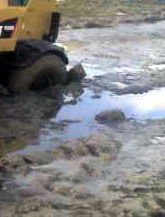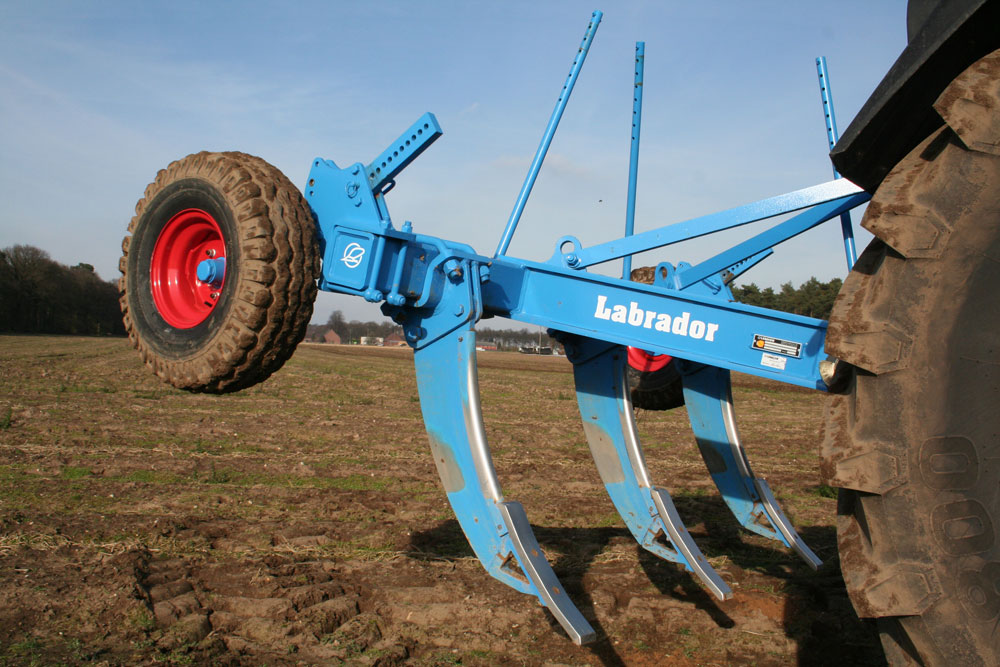There are plenty of reasons why homebuilders and renovators should pay attention to garden design, even before they start building work, but one keeps nagging at me – preserving the soil structure during construction.
 We’ve all seen the quagmire that a building site can become, especially during a wet winter. What isn’t so obvious, at least to the casual observer, is the damage that is being done to the underlying soil structure.
We’ve all seen the quagmire that a building site can become, especially during a wet winter. What isn’t so obvious, at least to the casual observer, is the damage that is being done to the underlying soil structure.
But what is soil structure? Soil consists of mineral particles, from microscopic clay particles to sand and stones. “Soil structure” describes the solid soil material and the continuity of spaces (pores) between the particles. Soil pores are vital for drainage, aeration and the growth of plant roots, and its here where soil organisms – bacteria, fungi, insects earthworms and beetles – live. A good soil structure is crumbly, and allows roots to penetrate, whist retaining water just long enough for plants to access it. (If you want to know more about soils, British Sugar have some useful guides which you can download here.) Simply put, plants won’t grow in soil with a poor structure.
The big risk during construction is compaction (and smearing) due to vehicle traffic – lorries making deliveries, diggers and dumper-trucks. How a soil reacts to these loads depends on several things, but water content is the critical factor: a hard, dry soil may just crack, but if it is too wet (soft and plastic when handled), soil compaction is inevitable. Compaction is where the soil particles are squeezed together, eliminating pores and forming a layer that is impregnable to water, roots, and air. Compaction doesn’t just affect topsoil, it can also occur in a deeper subsoil layer. The depth is further increased if fresh topsoil is brought onto site, once a house is completed, burying tyre ruts and left-over rubble.
Evidence of soil compaction comes much later, after the garden is planted – persistent wet spots and waterlogging, where plants just won’t thrive. A trial pit will most likely reveal a grey or black anaerobic layer – perhaps only a few centimeters thick, and anywhere up to 60 cm below the surface.
So what can you do , if you suspect the soil is compacted? Restoring a compacted subsoil is problematic: the compacted layer may be deep below the surface – deeper than regular cultivation will reach. Plant roots won’t break up compaction this deep, so mechanical intervention is called for.
Farmers use a “subsoiler”, towed behind a powerful tractor, to break up the compacted layer. (Note, this is quite different from a mole plough, which creates a drainage channel.) However, to be effective, sub-soiling must be carried out when the soil moisture content is just right: too dry and the soil stays in big chunks, too wet and it just creates more compaction. And remember it’s the moisture content at the right depth that counts, not just on the surface. The right conditions and implement depth can only really be established by trial and error. Even if you can find a landscaper with the equipment and expertise, it may not be feasible to use a tractor in the confined spaces of a garden, especially when there are underground drains, electrical cables etc. to be avoided. Then you really are stuck!
So the best solution is to avoid compaction in the first place. How? Well here are some key pointers:
- Avoid using machinery in wet conditions.
- Confine all vehicle and personnel traffic to areas that will form the drive and parking areas, and away from future planted areas of the garden (ideally, build the driveway early, to provide access). If this isn’t possible, consider using temporary roadway.
- Don’t handle soils when they are wet or plastic.
- Don’t stockpile soils inappropriately – ideally keep piles below 1m high.
Obviously, to be sure you don’t risk causing soil compaction in areas that will subsequently be planted, you need to have a fairly detailed garden plan.






Very informative, thanks! Another problem we have with construction equipment where I live is that fire ants are transmitted from one site to another. The ant colonize gaps in the machinery while they are left sitting in the field between use. Then the construction companies load up their vehicles and truck them to a new job, where the ants spread. I lived in the same neighborhood for years and never saw fire ants in this area until the school next to my house was torn down and rebuilt. Ouch!
Also, my dad lost many of the established trees on the homestead property he bought when the construction vehicles compacted the soil over their roots. The trees were one of his favorite things about the site and he didn’t realize building his home there would jeopardize them even if no one dug up the nearby soil. Thanks for bringing attention to this problem.
Thanks Eliza, you make a couple of important points.
Biosecurity is becomming an issue in many places – here in the UK we have problems with fungi that cause “sudden oak death” (Phytophthora ramorum), and “box blight” (Cylindrocladium buxicola). I’m planning to write something more on the subject in due course.
Damage to tree roots is really sad – often a slow lingering death over many years. One positive note is that, at least here in the UK again, the local planning authorities now require a root protection plan to be submitted when applying for building permission. The latest British Standard BS5837:2005 specifies really quite substantial protective fencing, too. So maybe fewer trees will succumb in the future